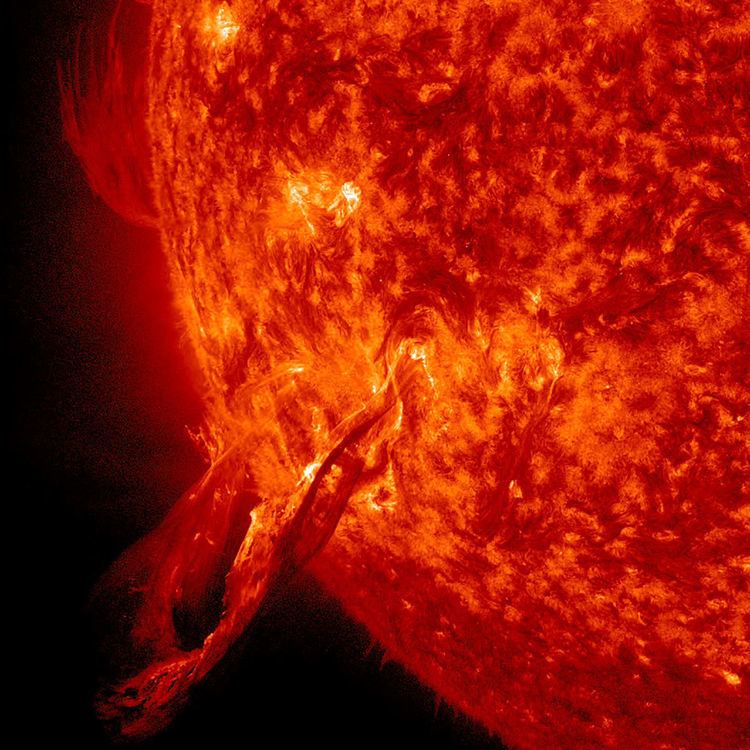 | ||
A Hyder flare is an intense brightening that occurs in the solar chromosphere. Unlike a solar flare, they are spotted away from the active regions or sunspot groups. Hyder Flares can be observed from Earth using a band filter of less than 0.1 nm, centered on a Hydrogen Alpha wavelength of 656.3 nm.
Contents
Hyder flares are caused when a magnetic trough rises to form a ridge shape, the pattern that is formed by this is what creates the visible flare.
Unlike solar flares, Hyder flares take a much longer time to reach peak intensity, as much as 30 to 80 minutes and then can continue for several hours. They have not caused any interference with Earthly communications like solar flares, and are rather weak.
The discovery of Hyder flares has been mainly associated with Charles Hyder who developed the mechanism describing them in 1967. Some disagree with Hyder’s findings and his mechanism, on what actually produces the flare.
Although rare, a notable occurrence that took place November 1, 2014, confirmed that they display special characteristics distinguishing them from solar flares.
Cause
The explanation for these solar flares comes from Hyder’s two-fold observations. One, flares tended to have a parallel ribbon shape to them with one on either side of the filament channel. Two, these flares were not caused by or associated with geomagnetic storms.
Quiescent filaments have been believed to belong to a magnetic trough, which can disappear due to the field’s reconfiguration. When this happens, the filamentary material is said to be thrown into the corona, creating a typical solar flare. Hyder explains that the process for Hyder flares differs, in that sometimes the filamentary material instead cascades down the outer sides of the elevated magnetic trough, or ridge, to interact with the lower chromospheric material that is producing the flare. If this falling process is not symmetrical on either side, then there will be a double parallel ribbon shape form, whereas a symmetrical fall will produce only a single parallel ribbon. A sporadic or insufficient fall of filamentary material will cause bright knots of solar flares to be produced.
History
Hyder flares were first noted by Max Waldmeier in 1938, who wrote a paper describing the phenomenon of suddenly disappearing filaments (disparition brusque), and mentioned that these can be associated with flare-like brightenings, but it was left to Charles Hyder to postulate the first comprehensive mechanism for such flares.
Following on work from his doctoral thesis with the University of Colorado in Boulder (1964), Hyder published two papers in the second volume of the journal Solar Physics (1967) in which the mechanism by which Hyder flares might occur was discussed in detail. Hyder was then on the staff of the (US) Air Force Cambridge Research Laboratories at the Sacramento Peak Observatory in New Mexico.
It was these papers in Solar Physics by which Hyder's name became associated with the flares in question, even though he was by no means the first to observe them.
Occurrences
As Hyder flares are notably rare, few occurrences have been recorded since their discovery, the first being on August 31, 2012, the second being on June 4, 2014. This solar flare occurred in the Southeastern Galactic quadrant. This flare spanned more than 500,000 kilometers (310,000 mi). It was recorded to have happened around 14:30 Coordinated Universal Time (UTC). After the flare took place, solar activity was low for 24 hours.
Another occurrence took place later that year on November 1, 2014. This flare was defined as a C-Class flare and happened between 0400 and 0600 UTC. Scientists noted that some material was sent back into the sun, which then caused several flashes of x-rays wherever they hit the surface of the sun. The remaining material flew out into space that formed a large core of Coronal Mass Ejection (CME) and gravitated away from the sun. It was not projected to hit Earth. Unlike the flare of June 2014, solar activity was high after the event even when no sunspots were detected.
Hazards/Controversy
Despite their size, Hyder flares generally do not have a high intensity. It is commonly accepted that there is no immediate threat to Earth from a solar flare 93 million miles away. These flares can potentially affect space weather, however, which could disrupt electronics. Because of this, many precautions must be taken into account to prevent damages to airplane navigation and/or government technologies.
Recently, the Hyder mechanism has come under question, most notably by Harold Zirin. Zirin questioned the filament falling down the side of the magnetic ridge, stating that magnetic reconfigurations will always create ejection. Comparisons to Hyder’s 1968 publications were discussed in Harold Zirin and D. Russo Lackner’s Volume 6, Issue 1 of Solar Physics pages 86-103: The Solar Flares of August 28 and 30, 1996.
